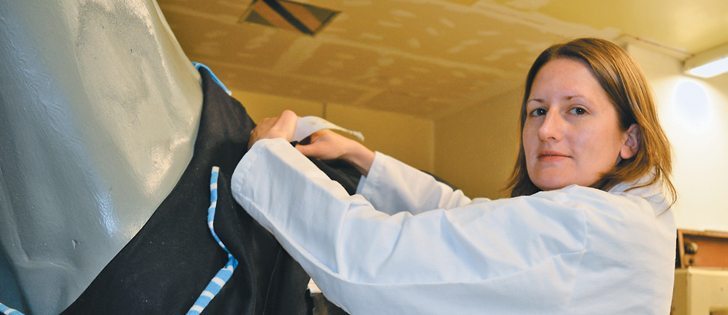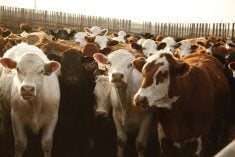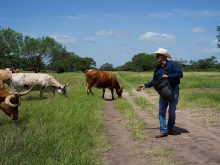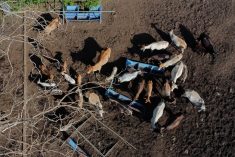The computerized system ‘weight compensates’ so that the animal can ‘weigh less’ and be more comfortable
Researchers at the University of Saskatchewan veterinary college are hoping to give animal rehabilitation a big lift.
The Western College of Veterinary Medicine (WCVM) and Saskatoon-based RMD Engineering, are creating a more effective and humane lifting device
It’s called the animal rehabilitation management system (ARMS) and it’s designed especially for horses.
Julia Montgomery, research supervisor at the large animal clinic at WCVM, said the lift should prove more comfortable for horses.
“What really makes ARMS special is that it’s a computerized lifting device, so it doesn’t mechanically lift the animal, but it will what we call weight compensate so it will take up a certain amount of the animal’s body weight so that the horse can basically weigh less.”
Montgomery, who has a PhD in equine immunology, said when horses have an injured leg, they will often shift weight loads to their healthy legs. The can cause supporting limb laminitis, a disease of the connective tissue around the hoof and coffin bone. When a horse increases its weight to the area, it can restrict blood flow and deplete essential nutrients. That can cause tearing of the support structure and sinking of the pedal bone.
The initial lift system tests included two healthy horses over five days. The horses were suspended in an Anderson Sling designed to lift large animals, while researchers monitored behaviour patterns and pressure sores, and tested for blood flow and muscle enzymes.
Read Also

Growth plates are instrumental in shaping a horse’s life
Young horse training plans and workloads must match their skeletal development. Failing to plan around growth plates can create lifelong physical problems.
They found heart rates were stable and muscle enzymes and blood flow to the foot were not affected.
However, the horses displayed increased respiratory rates and negative emotional associations with the sling as they spent more time in the harness.
“I am very excited about the progress we have made so far. We have certainly encountered some challenges and the next step is a better harness. We can only use this technology to its full potential if we pair it with a harness that we can do that with,” said Montgomery.
Montgomery and her team are also in the midst of creating a new sling. The new sling looks like a horse blanket and will be one complete piece. It also requires only one researcher to place it on the horse and allows for more mobility.
The Anderson Sling was helpful in the developing stages of the project, but not ideal for the long term, said Montgomery. Its main pick up point is under the abdomen and the new prototype will focus around the limbs.
“Based on our findings we designed the harness in a way that we think would work better. It’s really going to be more like a harness than a sling so it will be quite different” Montgomery said.
Jim Boire, president of RMD Engineering, runs research and development for the company.
Together, the team of engineers and veterinary specialists have brought in many other changes to diagnosis, treatment and rehabilitation techniques in animal medicine. They modernized the bovine tilt table at the college and manufactured the large animal positioning system for the Canadian Light Source synchrotron also located at the university.
“When you think that you’re building something that eventually would stop horses from having to be put down, you’re making a difference,” said Boire.
The WCVM eventually plans to use the new lift on client animals but for now it remains in testing.
“ (It) will be used on client owned animals but before we get to that point we want to make sure that its safe and we’re comfortable using it,” said Montgomery.
In addition to her work with the ARMS lift Montgomery is being honoured for her broader work. This year, the YWCA Women of Distinction Awards have recognized her as a leader and contributor in the research and technology category for the Saskatoon area.
tennessa.wild@producer.com















